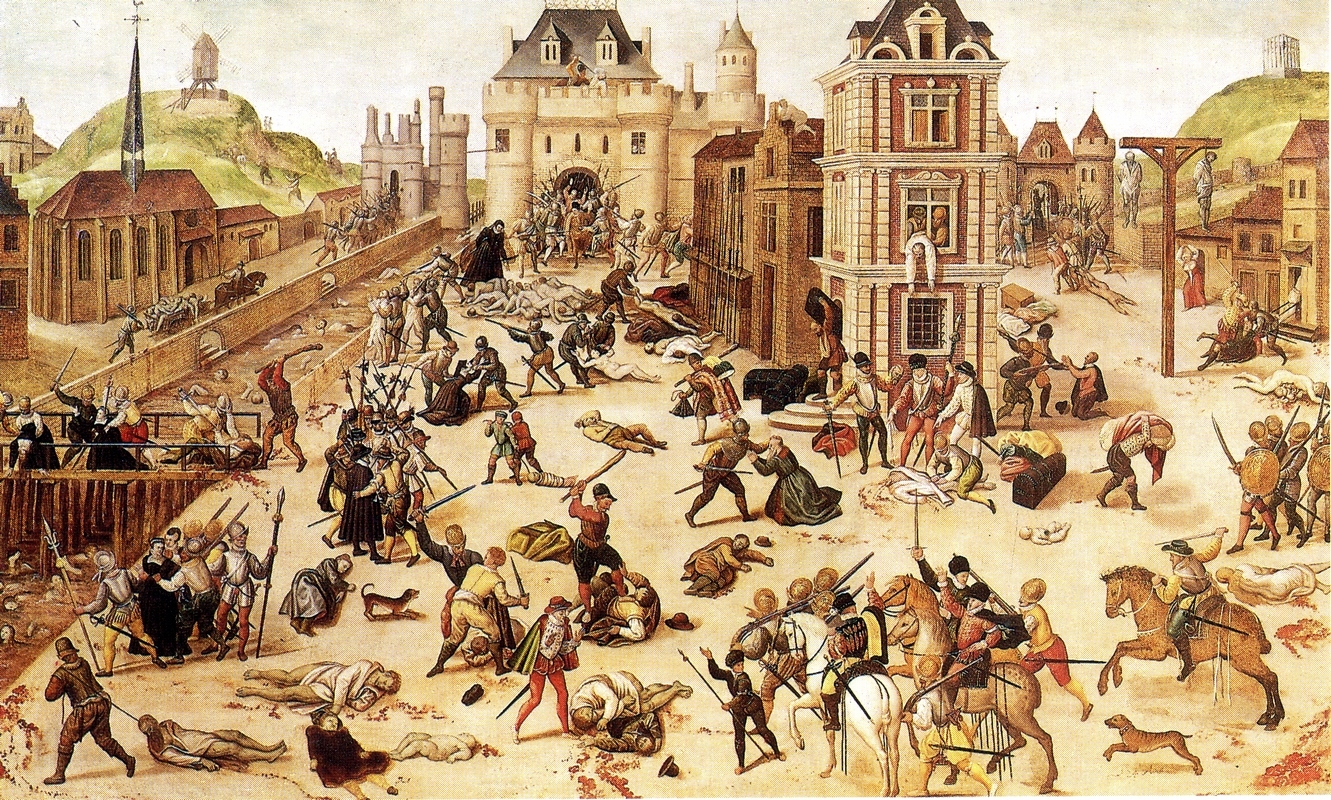The Unique Career of Marguerite de Valois, Queen of Navarre
Chapter 2 : Wedding Bells
The wedding took place outside Notre Dame Cathedral in Paris on 18 August 1572. It could not be held inside because of Henri de Navarre’s Protestantism. It was celebrated by the Cardinal de Bourbon (Henri’s Catholic uncle), so the service was Catholic but only just on hallowed ground. The usual nuptial Mass, which the groom did not attend, was delayed until after the wedding itself.
Standing on a platform raised high above the fascinated crowds, Marguerite accepted her destiny dressed à la royale – wearing a crown, a long ermine-covered robe covered with jewels, and a blue cloak trailing behind for yards held up by noblewomen.[9] Now she was Queen of Navarre.
There were three days of feasting followed by a musket blast. On 22 August the Huguenot leader Gaspard de Coligny[10] was shot in his shoulder by the Sieur de Maurevert who was aiming to kill. Maurevert fired from the upper storey of a house belonging to the Duke of Guise. Coligny was carried back to his lodgings alive. His little finger had been grazed and was amputated. The shot was extracted, his shoulder bandaged. Coligny decided to stay in Paris, perhaps trusting to royal protection (the King sent his own doctor to help with Coligny’s treatment). Nonetheless Charles IX and Catherine de Médicis had to think fast. Would Coligny’s followers look for reprisals?
On 23 August, the Eve of St Bartholomew’s Day,[11] Marguerite de Valois retired to her rooms in the Hôtel de Navarre in a state of fear. Her sister Claude had burst into tears when she, Marguerite, was taking leave of their mother that night, and was brusquely hushed by Catherine de Médicis. The new Queen of Navarre saw at once there was a secret which she was not allowed to share. Her husband’s armed retainers surrounded the bed, talking to each other all night.[12] At first light Marguerite dropped off to sleep relieved that the night was safely over.
She woke to the sound of blows on her bedroom door. The Queen’s nurse thought it was Henri de Navarre and therefore opened the door. Instead a blood-stained soldier staggered in, collapsed on her bed, calling out ‘Navarre, Navarre!’ Two other men, armed with bows and arrows, ran in behind. She begged for the stranger’s life to be spared, obtained the chivalric favour, then thought of her own. She snatched up a dressing-gown and ran through the streets of Paris to find safety with her brother the King. Marguerite fled through a field of battle. Men fought to the death around her.

What happened can be quickly explained. When Maurevert shot Coligny, he probably did so on the instructions of Henri de Guise (who held Coligny responsible for his own father’s death). It is still not clear who was behind the assassination attempt but Maurevert certainly did not act alone. Everything points to Guise.
However Charles IX and his mother thought they would be held responsible. Even if he was not party to the plot, it could be argued that the King’s job was to keep the Guise family under control while the Huguenots were in Paris. In short the King and his mother were terrified that the Huguenots would attack them in revenge. To protect himself, his mother, their supporters, the King ordered a pre-emptive strike by royal soldiers against the Huguenot leadership. Catherine de Médicis was complicit but may not have been the originator of this brutal plan (as many subsequently believed[13]). So much for reconciliation.
The King’s plan – his mother’s plan? their joint project? – was successful. Coligny was killed, his body thrown out of the window of his room, then savaged and burned by the crowd. Other Huguenot leaders were cut down. Catholic Parisians took their cue. Bloodlust seized them. They slaughtered Huguenot neighbours, men, women, children. At least Marguerite de Valois made it to the Louvre where she was protected by royal troops. So was her Huguenot husband. His attendants however – his friends – were butchered within earshot.[14]
Events ran out of control. The violence spread to other cities in the ensuing days and weeks. 5,000 or more died.[15] As we have seen the Queen Mother was a peace-maker by nature, however Marguerite’s memories of the evening of 23 August 1572 reinforce an impression of unfeeling hardness. Catherine de Médicis knew all about the forthcoming attack but would not risk it by warning her daughter. Marguerite survived despite her mother.
[9] Mémoires et Lettres de Marguerite de Valois (Paris 1843) p9 25-6
[10] Coligny assumed the leadership of the Huguenots after the death of the Prince de Condé, Henri de Navarre’s uncle, in 1569. Navarre’s father, Antoine de Bourbon, Duke of Vendôme, had died in 1562.
[11] The feast day of St Bartholomew in the Catholic calendar is 24 August.
[12] Bedrooms and beds were usually shared, and royal people usually had servants at sleep either in their room or very nearby.
[13] Including her daughter if we are to believe the account given in the Mémoires, however they were written a good twenty years later.
[14] See Marguerite’s account in her Mémoires pp 32-5
[15] For numbers see G. Treasure The Huguenots (YUP 2013) p 174










